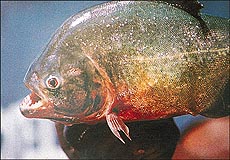












 










 
 
  |
Notorious
killers
Blood
in the water is said to whip a shoal of piranhas into a
demonic feeding frenzy, and although the smell of blood
or body fluids makes them more likely to bite, it is the
sight of the prey that triggers the attack, writes Nutan Shukla
STORIES of shoals of predatory
piranha attacking and devouring humans are more the stuff
of legend than of truth. However, these small fish, found
in Amazonian rivers, certainly have the potential for
such devastating attacks. Their schools have been
observed to skeletonise a 180- kg pig within minutes.
 Many fish have deadly teeth, but those of
the piranha have become the stuff of nightmares. Of the
20 or more species, four are recognised as notorious
killers. They have a mouth filled with razor-sharp,
triangular teeth designed to slice off bite-sized pieces
of flesh. A shoal, which can number hundreds if not
thousands of individuals, can reduce a large capybara to
a skeleton in less than 2 minutes. The fish pick the
bones clean. There is a classic description of a piranha
attack by William Innes, the doyen of home aquarium
keepers. He wrote of a pig being dipped into a
piranha-infested river and ‘each time it was lifted
out of the water, it was reduced in size.’ Many fish have deadly teeth, but those of
the piranha have become the stuff of nightmares. Of the
20 or more species, four are recognised as notorious
killers. They have a mouth filled with razor-sharp,
triangular teeth designed to slice off bite-sized pieces
of flesh. A shoal, which can number hundreds if not
thousands of individuals, can reduce a large capybara to
a skeleton in less than 2 minutes. The fish pick the
bones clean. There is a classic description of a piranha
attack by William Innes, the doyen of home aquarium
keepers. He wrote of a pig being dipped into a
piranha-infested river and ‘each time it was lifted
out of the water, it was reduced in size.’
Blood in the water is
said to whip a shoal of piranhas into a demonic feeding
frenzy, and although the smell of blood or body fluids
make them more likely to bite, it is the sight of the
prey that triggers the attack. Piranhas only attack fish
which are four times as long as they are wide.
Fortunately for their shoal-mates, piranhas themselves
are less than three times as long as they are wide.
Vying with the piranhas
for the title of the ‘world’s most ferocious
living fish’ must be the blue fish of the Atlantic
coast of the USA. It has been described as the ultimate
‘animated chopping machine’. A shoal, working
together, will tear into their prey, often fish little
smaller than themselves, leaving a trail of blood, flesh
fragments and pieces of entrails in their wake.
In the deep sea, small,
1-2ft-long dogfish form into roaming underwater packs.
Luminous light-emitting organs along the body enable pack
members to keep together in the dark of the abyss. They
hunt together taking squid larger than themselves. Like
angry wasps, it is thought that they swarm all over the
prey, anchoring themselves with their pointed top row of
teeth and slicing off chunks of flesh with the
razor-sharp lower band of teeth.
Dogfish are members of
the shark order and there are about 70 species. They are
found in the Atlantic Ocean and along the Pacific coast
of North America. They have long, slender bodies, large
fins and a long tail. Most are less than two metres long,
but the largest dogfish, the greenland shark, can grow as
long as six metres. Most of these fish are carnivorous
and eat small fish and other sea animals.
One species, the lesser
spotted dogfish, is the most common. It is often found on
sand banks where it hunts small fish, molluscs and
crustaceans, mostly at night. It grows up to 1 metre and
is covered by brown spots. It is also known as the rock
salmon or rough hound.
But perhaps the most
appealing story of undersea co-operation comes from
Australia. There, on the coral reefs of the Great Barrier
Reef, a small, brightly coloured, petal-like, pink, white
and blue gnathopyllid shrimp attacks starfish, including
the infamous crown-of -thorns, which is out of control
and gobbling huge sections of the vulnerable reef system.
Male-female pairs of shrimps work together and tickle the
starfish’s feet, which causes the spiny star to
loosen its hold on the coral. Gradually, they turn it
over. Once it is upside down, the shrimps feast on the
soft underside before the unfortunate starfish can
straighten itself.
|

